|
THE extension of the
railway system to Aberdeen sealed the fate of the old Trades Hall. When
the Aberdeen Railway was projected in 1844, the hall and site, which
extended from the foot of the Shiprow to near the present line of
railway, were scheduled, and although not required for railway purposes,
the buildings had to come down when Guild Street and Exchange Street
were constructed. The last of the buildings was taken down in 1857, and
while the excavating operations were in progress a careful watch was
kept for relics and antiquities, the following notes being taken by a
local antiquarian at the time :—" A great number of human bones were
found when the digging for Guild Street commenced, which had probably
been the site of the ancient burial grounds of the Trinity Friars. It
had extended to the south end of the convent, and ran east from the side
of the church for some space. The bones were generally in a very great
state of decay, the skulls dropping to pieces when lifted. The remains
of a coffin in one instance were found, which fell to dust on exposure.
About the middle of this part of the ground were found a bit of iron
resembling a key, and the bowl of a small spoon curiously ribbed on the
back. The foundation walls of the hall, which were probably those of the
old convent, were built with lime on the outside and with clay between
the stones. The walls were several feet in thickness. At the east end of
the hall, twelve or thirteen feet below the surface, were found the
remains of a more ancient building, composed of rude stones cemented
with clay. Below some of the lowest were found oaken boards which seem
to have formed part of some ancient vessel, and near the same place five
or six oaken beams were found, which had probably supported rafters in
the old building (King William the Lion's
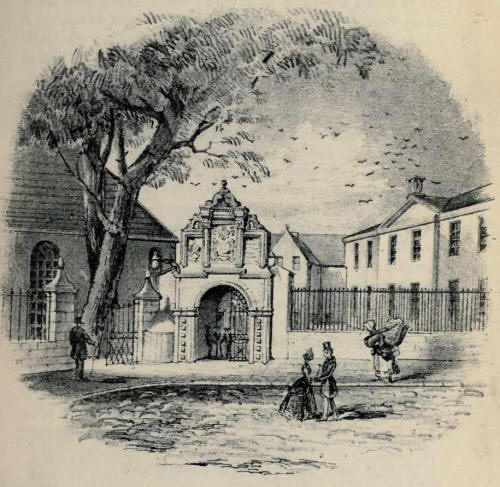
Old Trades Hall
palace). They had holes
in the side as for the ends of posts being morticed into them. The
ground here was very moist, puddled with clay and small stones. On
excavating westward, the old wall was found continued along the side of
the more modern one at the distance of about fourteen inches. About the
middle of this part of the building a silver tablespoon was found, much
corroded as if by the action of fire. A portion of what looked like a
buff jerkin, and some remains of old shoes with very large hobnails in
the heels, were also found."
Many interesting relics
were transferred from the old hall to the new buildings in Union Street.
The collection of antique oak chairs, presented from time to time for
the use of the deacons of the different Trades, has been long looked
upon as the most complete of its kind in Scotland. Some of them date
from the time that the craftsmen held their meetings in the deacons'
houses, while it is tolerably certain that one of the largest chairs
belonged to the old monastery. This chair is mentioned in an "inventory
of the plenishings belonging to the Trinity Hall, taken in presence of
Patrick Whyt, Deacon Conveener, 1696," as "King William's Cheer," and
although some of the framework has evidently been renewed, the panels
(showing carved heads of monks and warriors) evidently belong to the
early monkish period. The Convener's chair, which stands about six feet
high, has finely-carved Gothic. panels; and some of the other chairs of
smaller size exhibit no small amount of originality of design and
finish. The inventory taken in 1696 gives the following list of chairs,
&c., all of which are in the new hall, and in an excellent state of
preservation :—
King William's cheer and
pictur.
Hammermen—Ane cheer,
gifted by Lawrence Afersar for the use of said Traid; ane cheer, gifted
by Matthew Guild, armourer; ane cheer, gifted by George Anderson,
goldsmith, Deacon Conveener in 1609 ; ane cheer, gifted by William
Anderson, goldsmith, Deacon Conveener, 1654; ane cheer, gifted by
Alexander Paterson, arulourer, Deacon Conveener, with his pictur, 1685;
ane cheer, gifted by Patrick Whyt, bookmaker, Deacon Conveener, with his
pictur, 1690; ane cheer, gifted by James Anderson, glazier, 1692.
Bakers—Ane cheer, gifted
by John Middleton, baxter, Deacon Conveener, 1634; ane cheer, gifted by
Christian Mitchell, daughter to William Chapman, sometime Deacon of the
Baxters, 1668, and another on Januar, 1704.
Wrights and Coopers—Ane
cheer, gifted by Jerome Blak, couper, 1574; ane cheer, gifted by William
Ord, wright, Deacon Conveener, 1635.
Taylziours—Ane cheer,
gifted by Thomson Cordyn, taylyer, Deacon Convener, 1627; ane cheer or
round table, gifted by Alexander Cocnie, taylyer ; ane cheer gifted by
John Forbes, tailyeur, 1694.
Shoemakers—Ane cheer,
gifted by Thomas Robertson, shoemaker, Deacon Convener, 1633; ane cheer,
gifted by Alexander Idle, shoemaker, Deacon Convener, 1679; ane cheer,
gifted by William Dickson, late Deacon, 1686.
Weavers—Ane public cheer
for their Deacon, 1684.
Fleshers—Ane cheer,
gifted by Andrew Watson, Deacon; ane cheer, gifted by John Craighead,
Deacon.
Ane cheer marked W. P.
coft (bought) to the Hospital; ane cheer, gifted by John Archibald.
Of the five chairs
belonging to the Hammermen Trade the oldest (Fig. II.) is that supposed
to have been gifted by
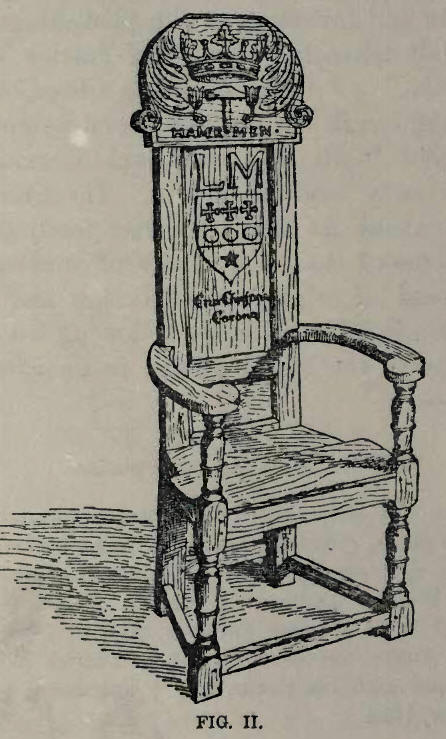
Laurens Mercer, a
contemporary of Matthew Guild. The chair bears no date, but simply the
initials "L. M.," with the arms of the Mercer family (on a Tess, three
bezants; a mullet in base and three crosses, potent in chief) and
underneath the motto—Crux Christi'mea corona. Laurens Mercer was several
times deacon of his craft from 1572 to 1596, and although others of the
same name joined the trade some time after, the chair, from its
appearance and construction, bears evidence of having been presented by
the Mercer who figured so prominently in Matthew Guild's time, and who
also shared the same punishment as Guild for "cumy ng throch the
Gallowgett on a Sunday with ane menstrall playand befor thaim."
A chair presented by
Jerome Blak in 1574 is ornamented with a carving of the Black arms (a
saltire, between a crescent in base, a mullet, in chief; for crest a
hand holding a cooper's adze, in dexter proper). The chairs presented
about the middle of the seventeenth century are all of superior design
and better construction, the chair presented by Andrew Watson, flesher,
in 1661 (Fig. III.),
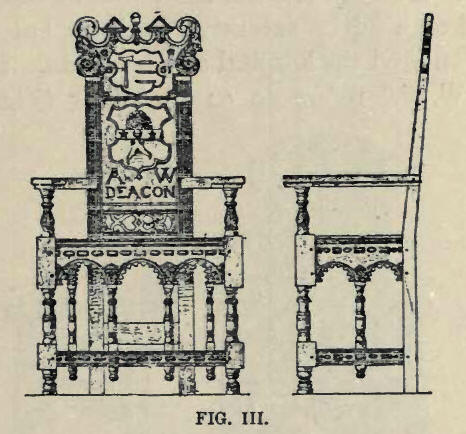
being about the most
elaborate. The arms of his trade are carved and coloured on the upper
part of the back, and on the centre are the arms of the Watson family
(an oak tree eradicated in base, surmounted by a Less, charged with
crescent, between two mullets). Watson was deacon when the Flesher Trade
was joined to the other six under Dr. Guild's deed of mortification for
the administration of the Trades Hospital. The chair presented by
Alexander Idle, shoemaker, in 1679 (Fig. IV.), has the crown and cutting
knife of his craft
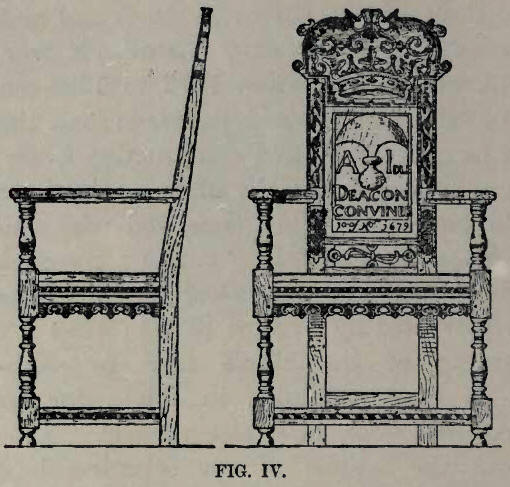
carved in the back, with
his name, "A. Idle, Deacon-Conviner, 30th November, 1679." Idle had a
somewhat chequered career. The books of his trade show that at one time
he must have carried on a fairly extensive business, but in the end of
his days he entered the hospital as a beadman. It is uncertain who the
"W. P." refers to on the chair (Fig. V.), which,

according to the
inventory was bought by the Master of Hospital prior to 1696. It bears
the Paterson arms (a fess; in base, three pelicans vulnin; three mullets
in chief). Patrick Whyt, hookmaker, presented a portrait of himself, as
well as a chair (Fig. `'I.). He was several times deacon of the
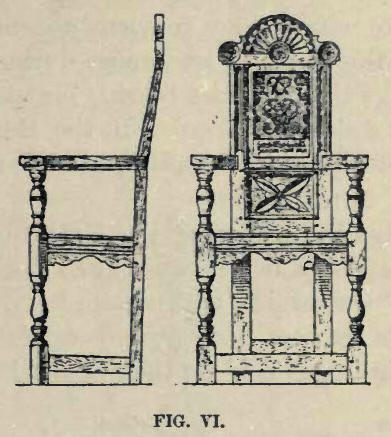
Hammermen Trade, with
which the hookmakers were associated, and was also elected
Deacon-Convener in 1690.
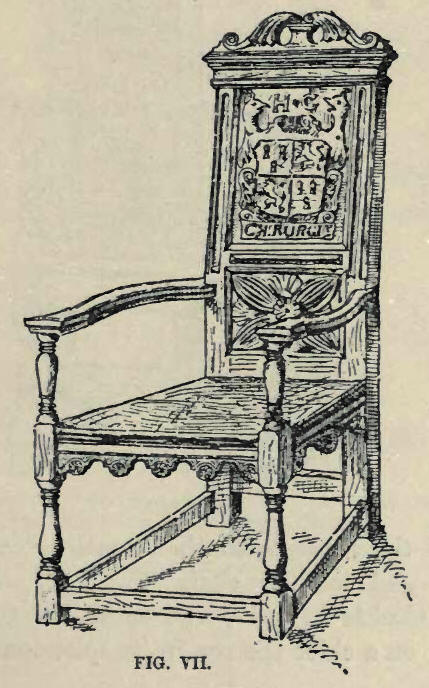
At that time hookmaking
seems to have been somewhat extensively carried on, as numbers of
apprentices appear on records as having been indentured to the calling,
which, by the way, included reedmaking and all working in wire
generally. Wire windows are frequently mentioned as essays prescribed
for this class of tradesmen during the sixteenth century. Whyt's chair,
besides bearing his name and designation in full, has a shield charged
with the Haminermen arms, and also two fishing hooks in saltire, and one
in pale with the initials "P. W." in monogram.
A chair (Fig. VII.)
bearing the Guthrie arms (I and 4 three garbs; 2 and 3, a lion rampant)
and the initials "H. G.," with the word " Chirurgie " underneath, is
evidently a relic of the Leechers or Barbers Society, now extinct. The
weavers provided a chair (Fig. VIII.) for their deacon in 1684. It bears
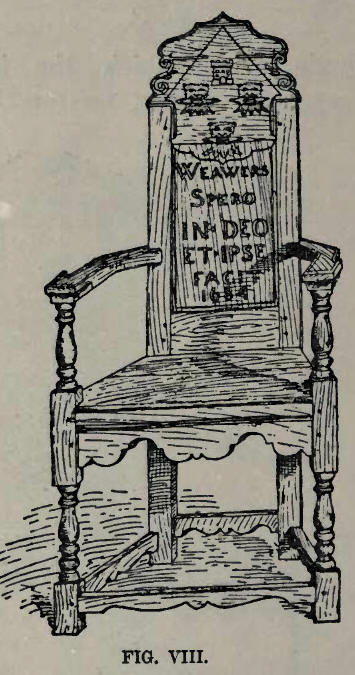
the arms of the trade,
with their motto, Spero in Deo et ipse facit. An odd looking chair (Fig.
IX.) was presented by Alexander Cockie in 1617, who embellished it with
his arms —"a cock; on a chief the sun in its splendour, and a crescent
between two mullets," and his initials "A. C." The back folds down upon
the arms, and forms a most convenient card table. On one of the chairs
belonging to the Bakers is a portion of the Bakers arms, and also the
Middleton arms, with the inscription, "My soul prais thou the Lord. I.
M. John Midleton, deacon, 1634." Thomas Robertsone, who presented a
chair to the Shoemakers in 1633 bearing the inscription "Thomas
Robertsone, Deacon-Conviner, Grace me God, 1633," was killed
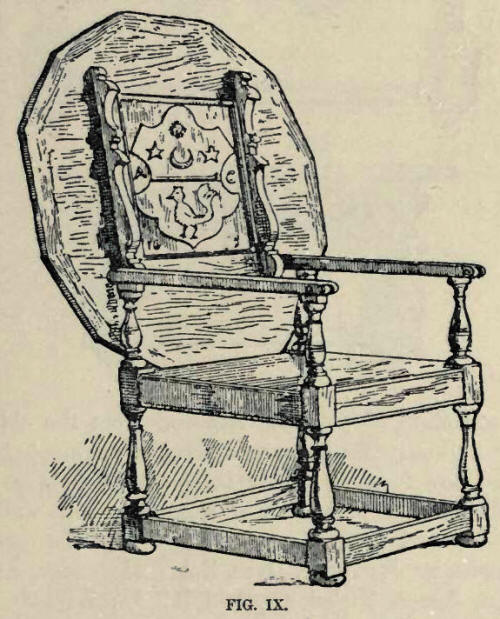
on the 13th September,
1644, at the battle of Justice Mills or Craibstane during the cov
enantinc troubles. Three other cordiners were killed in the same affray.
There are also two
massive oak tables [On 10th November, 1699, "the Convener Court ordained
Charles Sangster, Master of Traids Hospital, to employ and pay William
Coutts, Deacon Convener, for repairing the great table in the Trinities.
Lykwise the said William Coutts accepted of the said employment and
promised to project the work betwixt the Pasch next, under the faiilzie
of ten dollars, and thereupon has subscribed these presents." And,
again, on 18th January, 1703, "the Convener Court ordains the Master of
Hospital to cause mak up the red marble table, and to mak use of the
great wainscot table in their church for that effect."] in the hall, at
one of which it is said the Lion King was wont to preside. Both tables
have stone tops about six inches in thickness. On the ends of one of the
tables are shields, one being the Guild family badge, and the other the
initials "D. W. G." We give side and end elevations of the principal
table.
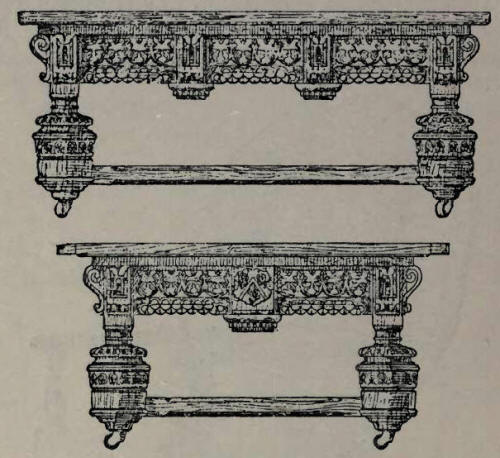
The collection of
portraits removed from the old hall to the new building has been
considerably augmented of late years, and now forms a highly interesting
collection both as works of art and as memorials of worthy citizens well
known in their day and generation. When we mention that there are
examples by Jarnesone, Dyce, R.A.; Alexander, Archibald Robertson,
Joseph Nisbet, G. Reid, R.S.A.; William Niddrie, James Cassie, A.R.S.A.;
J. Giles, R.S.A.; J. Stirling, J. Mitchell, and G. W. Wilson, it will be
seen that the collection is fairly representative of the works of local
artists.
The curious production
representative of William the Lion is one of the few relics of the
Trinity Monastery. When and by whom it was originally painted are
matters apparently now beyond human 'ken, and not a little of its
artistic value has been lost on account of a "repairing" which it
underwent in 1715. In that year the Convener Court "granted warrant to
William Anderson, present Master of Hospital, to agree with
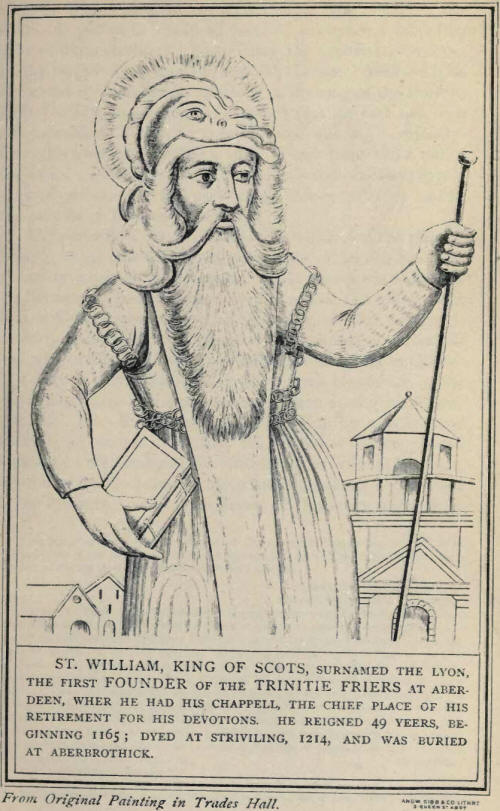
Charles Whyt, painter,
anent renewing King William the Lyon, his pictur, as cheap as possible,
always not exceeding fifty shillings sterling." Fortunately the
"renewing" did not go the length of any interference with the face. We
have it on the authority of an artist who took a drawing of the work in
1821 for Lieutenant-General Hutton [David Anderson of Finzeauch, the
artist's uncle, was married to Jean, sister to Dr. Guild.] that the face
had been left untouched. The king is represented wearing a
curiously-formed helmet, and holding a book in one hand and a rod in the
other. There is a chain round his waist—indicative, it is said, of
penance for the part which history says he had in the murder of
Thomas-a-Becket.
The portrait of Dr.
William Guild, which gets the place of honour in the new hall, bears no
artist's name, but has been generally ascribed to Jamesone. Guild was a
contemporary of Jamesone's, is said to have been at school and college
with him, and was, moreover, a close relation; so that nothing is more
probable than that Jamesone had painted a portrait of one who as
Principal of King's College, a chaplain to Charles I., a leading
ecclesiastic, and as a generous benefactor to the town, must have held a
prominent position among his fellow-citizens. That the picture was
touched up by a later hand there is no doubt. In 1741, the Convener
Court granted warrant to the Master of Hospital to pay to William
Mossman, a guinea "for his pains and trouble in repairing Dr. William
Guild's picture ;" and in the Master of Hospital's accounts for
"An engraving from a
drawing taken about 18.0 appears in Volume III, pave 298, of the
"Transactions of the Antiquarian Society of Scotland," along with the
following letter from Lieutenant-General Hutton to the secretary of the
Society :-
"London, 34 Southampton
Row,
"Russell Square, 22nd Oct., 1821.
"Dear Sir,—I request the
favour of you to present from me to the Society the picture of King
William the Lyon, which I took the liberty of sending to your care
lately, and I shall be much honoured if it should be deemed worthy of a
place in the Society's museum. It is a copy made by an artist a few
years ago from the original painting, which is supposed to have belonged
to the Monastery of the Trinity Friars of Aberdeen, of which the King
was the founder, and is now preserved in Trinity Hall there. It appears
from the records of the Incorporated Trades of Aberdeen that in the year
1715, it having become much defaced in consequence of its great age, an
agreement was made with Charles White, a painter, to repair it for a sum
not exceeding fifty shillings sterling, which was accordingly done, with
the exception of the face, which, the artist who copied the picture
informed me, has been fortunately left untouched. It is painted in
fresco, and its dimensions are about four feet in height by about two
feet nine inches in breadth.—I remain, yours &c., "H. Hutton.
"John Dillon, Esq., Secretary."
the following year there
appears—"By cash to William Moss-man, painter, for mending Dr. Guild's
picture, £12 12s. Scots." This sum is equivalent to twenty-one shillings
sterling. [At the same time the Convener Court expended about £500 Scots
in decorating the hall, the Master of Hospital having been authorised
"to employ Robert Norrie, of Edinburgh, painter, to mint and colour the
Trin,tie Hall in the Lest and genteclest manner."] On the 18th May,
1731, the Convener Court granted warrant "to their Master of Hospital,
at the sight of the deacons, to satisfie and pay William Mossman,
painter, for drawing Dr. William Guild, their foundator, his picture,
for which this is warrand." This seems to have been an order for a
drawing taken from the original, which there are good reasons for
believing is the picture now in the hall, and for mending which Mossman
was paid a guinea ten years after. It is hardly probable that his own
drawing could have required "mending" so soon after it was executed. It
is much more likely that, in 1731, Jamesone's original had been showing
signs of decay, that Mossman had been ordered to make a copy of it ; and
that then ten years after he had been employed to " m rend " the
original itself. The picture, as it stands, notwithstanding its
renovation, is an excellent one. An admirable engraving was taken from
it some years ago by R. M. Hodgson, who also ascribes the original to
Jamesone.
With regard to the
portrait of Matthew Guild, father of Dr. Guild, there is less doubt of
its being a genuine Jamesone. It bears the inscription, -which Jamesone
put upon nearly all his portraits—the date of the birth and age of the
subject; and we have also the familiar broad hat which appears in not a
few of Jamesone's male figures.
There also hang in the
new hall several examples by Cosmo John Alexander, a grandson of
Jamesone's, all very fair specimens of portraiture. The portrait of
Alexander Webster, advocate, by Dyce, is justly regarded as one of the
finest bits of portraiture in the collection, and has on more than one
occasion been exhibited in collections of old Scottish masters in the
south. Alexander Webster had no direct connection with the Trades, but
he took a warm interest in the Trades School, which was instituted in
1808, about the time his father held the office of Deacon-Convener.
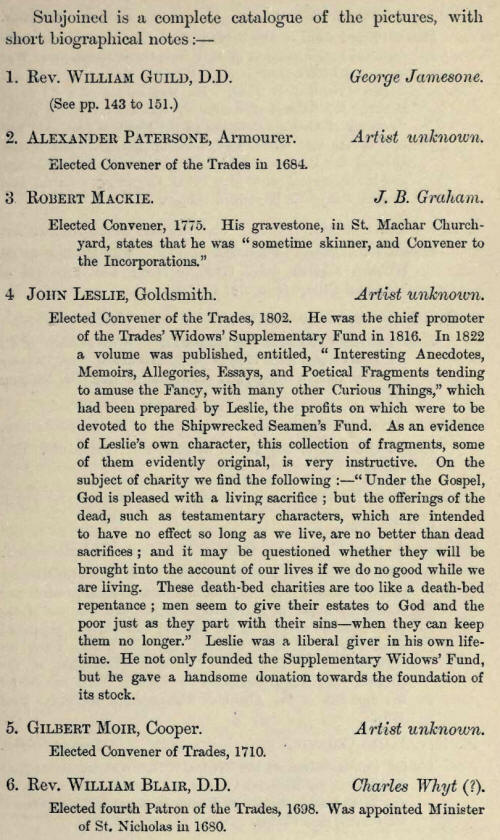
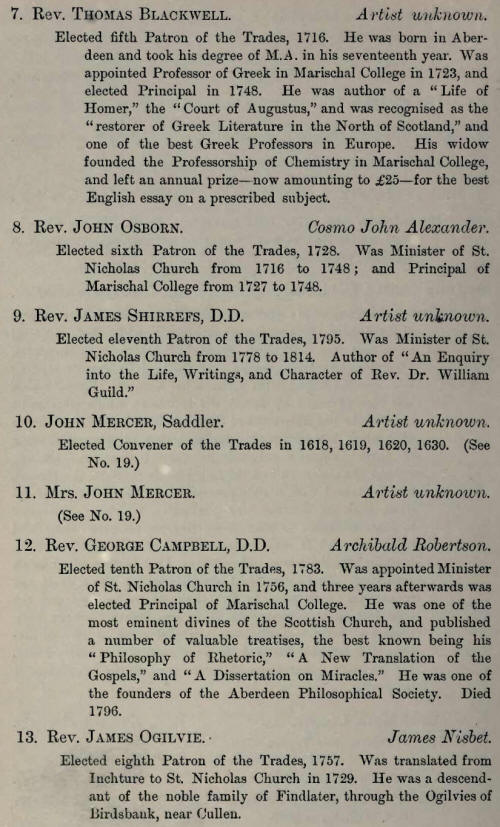
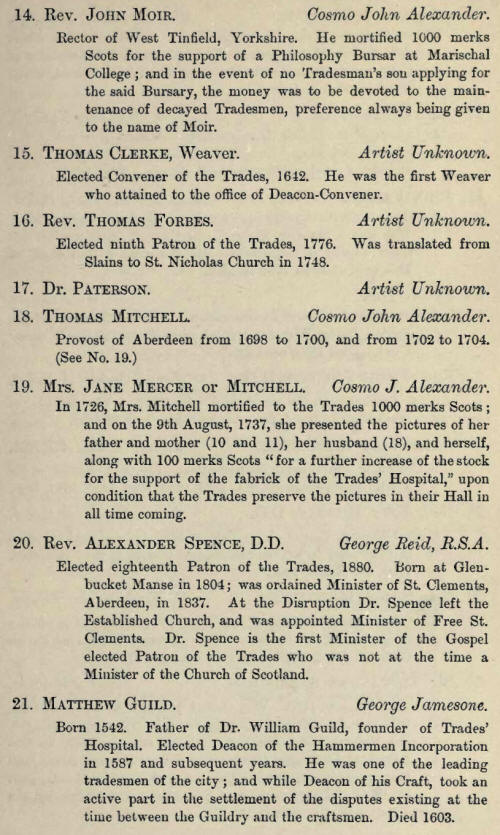
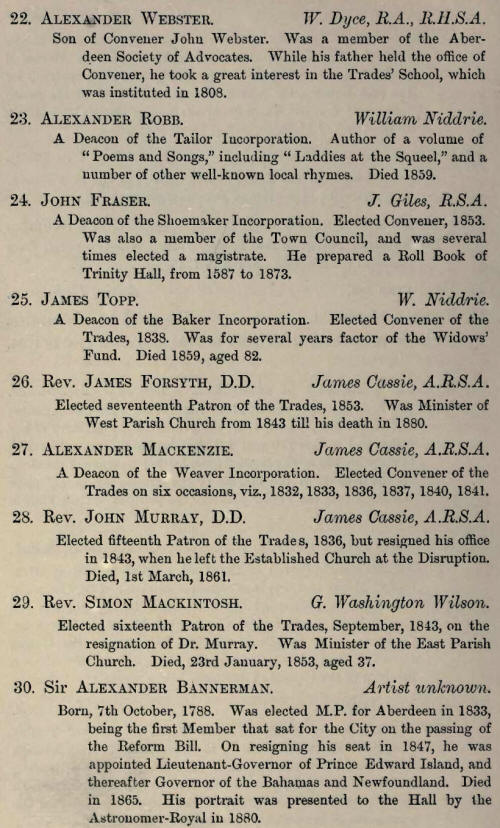
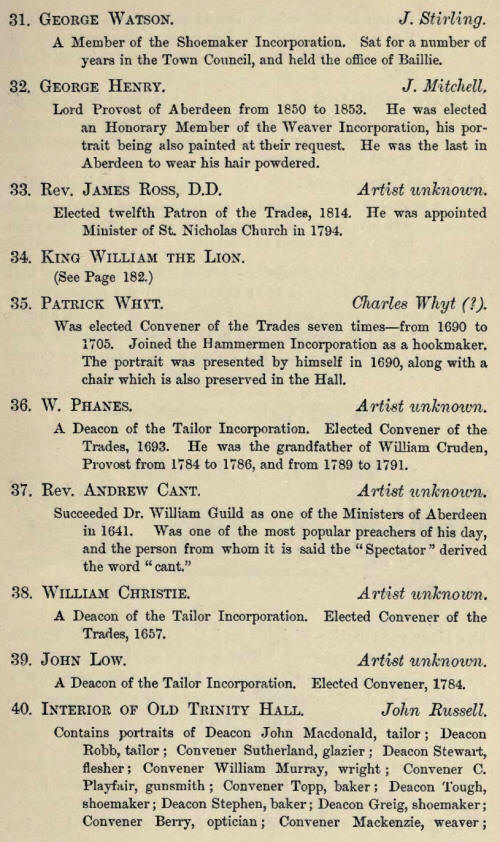
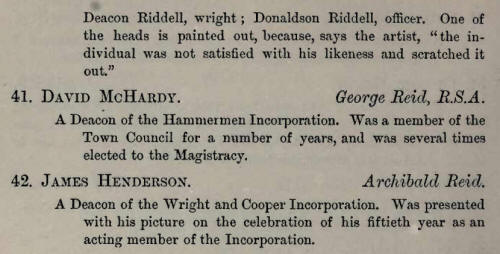
Among other relics
transferred from the old to the new hall were three swords (see p. 109)
belonging to the Hammermen, Tailors, and Weavers, and several remnants
of banners said to have been used at the pageants in the pre-Reformation
days. The punch bowls (Fig. X.) belonging to the Convener Court,
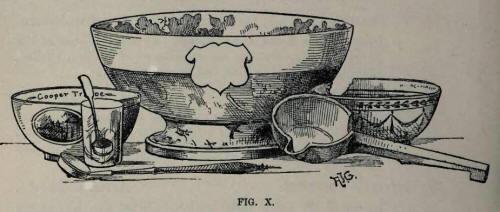
the Hammermen, the
Wrights and Coopers, and the Tailors, have also been preserved. The
largest bowl was presented to the Hammermen by Convener Aleck, who,
although a shoemaker himself, presented the bowl to the Haminermen
because he considered "they were the best brewers and drinkers of punch
among the whole of the craftsmen." This bowl is about two feet in
diameter, and stands fully twelve inches high. The two large Bibles that
were wont to be used in the Hospital are also in the Master of
Hospital's press. One of them is a 1578 Bible, but has been allowed to
fall into a very tattered condition; the other, dated 1672, is in a
better state of preservation.
It can well be believed
that the craftsmen quitted their old hall, so full of interesting
historical associations, with feelings of deep regret. It was a
veritable breaking away from the past; and coming as it did about the
time that the special privileges of the craftsmen were abolished, their
regret was rendered all the more sincere. When a proposal was made to
erect a new hall, a veteran craftsman was heard to declare that before
he would quit the old building he would rather subscribe "to have every
stone of it clasped together with silver "than give a penny to build a
new place of meeting. Another member, Deacon Alexander Robb, a local
poet with no mean talent for versification, sang the following lines at
one of the last convivial gatherings held in the old hall, to the tune
of "Happy are we a' thegither ":-
O banish,
Muse, a' thoughts o' sadness,
Soun' your notes baith clear and bright,
Be naething heard but strains o' gladness
On this happy festive night.
The Muse reply'd, in deep dejection,
How can I my chanter blaw
In notes o' joy—the last election
That tak's place within this ha'.
When
reminiscent mem'ry traces
A' the scenes that here hae been,
The kindly hearts, the happy faces
That aroun' this board I've seen:
Then comes the sick'ning, sad reflection,
When I look aroun' you a'
This is, alas! the Iast election
E'er we'll see within this ha'.
Nae mair at
sovereign's coronation
Will the festive board be spread;
Nae mair we'll hear the grand oration
When a king or queen is wed;
Nae mair, wi' shouts o' satisfaction,
Raise the loud hip, hip, hurra
For, oh ! this is the last election
E'er will happen in this ha'.
Nae mair will
lords or earls be treated,
Whan they come to visit here;
Nae mair Lord Chancellors [*] be seated
Close to our Convener's chair.
These glorious scenes o' retrospection
Soon will fade like melting snaw,
For, oh! this is the last election
In our famous ancient ha'.
Nae mair the
cheerf u' sang amusin'
Will re-echo through those wa's;
Nae mair the bursts of elocution
Bring down thunders o' applause.
My heart is sad when I consider,
Ere anither year or twa,
That nae ae stane upon anither
Will be left o' a' this ha'.
But whare's
the use o' waefu' skirlin',
Lat us a' be happy yet,
Altho' rail trains will soon be dirlin'
O'er the spot whare now we sit.
[*] Deacon Robb was not
indulging in imaginative flights when he alluded to Lords and Earls and
Lord Chancellors having honoured the Auld Tarrnty Ila' with their
presence. The Earls Marischal and Huntly, and in later times Lord
Brougham and Mr. Joseph Hume, are mentioned in the Trades' records as
having partaken of the hospitality of the craftsmen. When Lord Brougham
visited Aberdeen in 1834 he was presented with an address in Trinity
Hall, to which he replied:—"Gentlemen, I beg leave to return my warmest
thanks for the kind manner in which you have received me, and I will
never forget, so long as I live, the reception I have received from all
classes—from the Incorporations and the inhabitants, civil and
religious, in the great, the ancient, the loyal, and the flourishing
city of Aberdeen. This is the first time I have been in any large
meeting of my fellow-countrymen since great changes have been effected
in the representation of the people of Scotland; and as I will shortly
return to London I shall have the satisfaction to assure my Sovereign
and my colleagues of the excellent working of the system of which they
were the authors, and of which I, amongst others, had a humble share."
Some years previous (in 1820), Mr. Joseph Hume also visited Aberdeen,
and the craftsmen took occasion to offer their thanks to the eminent
economist for his "patriotic, able, and independent conduct, and
particularly for his unwearied exertions in behalf of the burgh of
Aberdeen." Mr Hume, we are informed by the minute in the Convener Court
Books, "gave a speech of considerable length on Scotch Burgh Reform, and
assured the meeting that if he were again returned a member for this
district of burghs he should still persevere in the same independent and
upright line of conduct he had hitherto pursued. Whereupon the meeting
having been so much gratified and honoured by Mr. flume's company,
requested him to drink a glass of wine with them, which he most readily
accepted, and after loyal and patriotic toasts, Mr. flume's health was
drunk with three times three and Ioud applause. Mr. flume returned them
thanks, and expressed himself in the most handsome and flattering terms,
and Mr. Hume being under pressing engagements to leave this place, drank
the health of the Corporations and retired. The whole proceedings were
conducted in the most gratifying manner, and the evening was spent with
the utmost hilarity and good humour." The Convener's signature to this
minute is conspicuously absent!
O, never lat
us be down-hearted,
"Let us drive dull care awa,"
Nor think our glory is departed
Whan we leave our ancient ha'.
Anither ha'
will soon be finished
Whare the sang o' joy shall rise,
Our comforts a' be undiminished
A Corporation never dies.
Then why su'd we be now unhappy,
Sorrow disna' set's ava;
Push about the enlivenin' drappie
Soon we'll get anither ha'.
The new Trades Hall,
situated at the south-east end of Union Bridge, was erected in 1846
after plans by Mr. John Smith, architect (see frontispiece). The main
entrance is from Union Street, and on the first floor are the hall,
measuring sixty feet by thirty feet, with open ornamental roof; two
committee rooms, a common room, and retiring room. From the Denburnside,
entrance is obtained to the school rooms, used as a Trades School down
to 1878. In the upper portion of the building are the kitchen and
housekeeper's apartments; and immediately above the school is the strong
room, in which are stored the books and papers belonging to the
different Incorporations. |

